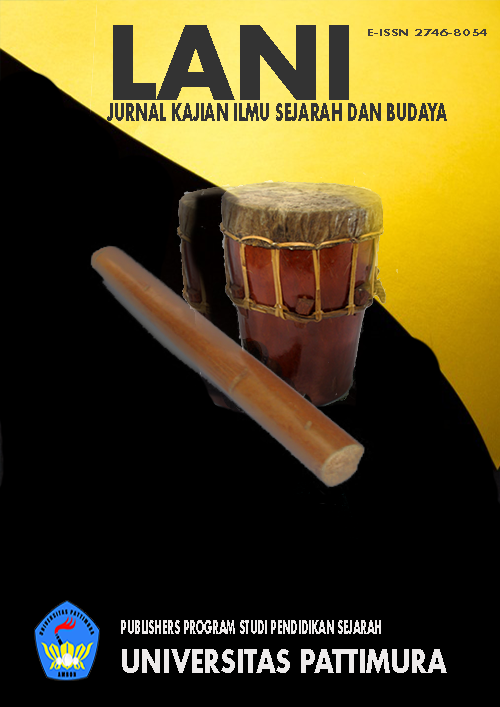Sejarah Etnis Tionghoa Dalam Dinamika Sosial Masyarakat Pulau Buru
The History of the Chinese Ethnic Group in the Social Dynamics of Buru Island Society
Abstract
The people who inhabit the island of Buru come from various places; among them, some groupings differentiate from one another and are known as Rana people, Wakahallo people, Orangakang, Earth lale people and traders. Of the five designations, this study focuses on "Trading People". In this case, the Chinese community. They also play an essential role in various community life sectors on Buru Island. Their existence is identified through names such as "Chinese Namlea, Chinese Namrole, Chinese Waplau and Chinese Buru". The purpose of this research is to explore the history of the arrival of the Chinese community on Buru Island and to identify the dynamics of Chinese life in terms of social, economic, political, and cultural aspects of Buru Island. To achieve this goal, the historical method was used in four stages: heuristics, verification, interpretation, and historiography. The number of Chinese communities on Buru Island is large and spread over several locations in several sub-districts. They live side by side with the local population without a barrier in the form of a high wall to separate them from the surrounding community. Their livelihoods generally are trading groceries and necessities and building materials for houses. In addition, they can also take advantage of the availability of natural resources on the island of Buru, namely eucalyptus oil and make it an important trading commodity with high economic value. Even though they have adhered to Christianity and Islam, they still maintain the Chinese tradition from their ancestors. Besides the trade sector, Chinese people in Buru have played an essential role in politics.
Downloads
References
Agustan dan Tamrin Sopian, Merantau: Studi Tentang Faktor Pendorong Dan Dampak Sosial Ekonomi Terhadap Aktivitas Merantau Di Desa Sijelling Kecamatan Tellu Siattinge Kabupaten Bone Oleh: Program Studi Sosiologi Fakultas Ilmu Sosial Universitas Negeri Makassar
Alexander Darakay Boy, (2012). Orang Cina di Aru,Artikel
Badan Pusat Statistik, (2012). Kabupaten Buru
Galih Bayu, (2020). Menelusuri Sejarah Awal Masuknya Masyarakat Tionghoa di Indonesia.",:Kompas.com
Giddens Anthony, (2010). Teori Strukturasi, Dasar-Dasar Pembentukan Struktur Sosial Masyarakat, Jakarta: Pustaka Pelajar
Frederick Barth,(1988). “Kelompok etnik dan Batasannya, Tatanan Sosial dari Perbedaan Kebudayaan”, Penerbit Universitas Indonesia Press Jakarta.
Karmela Siti Heidi, Pamungkas Satriyo, Kehidupan Sosial Ekonomi Orang-Orang Tionghoa Di Kota Jambi, Jurnal Ilmiah DIKDAYA
Koentjaraningrat, 1984. Metode-metode Penelitian Masyarakat; Gramedia; UI Press Jakarta;
Lina Chusna Nur, (2009). Awal Kedatangan Orang-Orang Cina Di Nusantara Hingga Masuk Ke Bogor, Thesis.FIB Universitas Indonesia
Lan Fung Yu Lan, (2007). Sejarah Filsafat Cina, Jakarta: Sinar Harapan.
Maspaitella Elifas Tomix, (2010). Jejak Cina Di Maluku, Suatu Hermeneutika Sejarah Artikel
P. Hariono, (1993). Kultur Cina dan Jawa: Pemahaman Menuju Asimilasi Kultural, Yogyakarta: Pustaka Pelajar.
Reyper Roy.R.J, (2011). Integrasi Sosial antara golongan Tionghoa dan Etnik Ambon. Tesis
Wirawan.I.B, 2012. Teori-Teori Sosial Dalam Tiga Paradigma, Penerbit Pranamedia Group
Yerri Wirawan, 2013. Sejarah Etnik Tionghoa Makassar, Dari abad ke-7 Hingga ke-20 Penerbit PT.Gramedia Jakarta
Rahman Hamid ABD & Muhamad Saleh Madjid, 2011. Pengantar Ilmu Sejarah,
Peraturan Presiden Nomor 10 Tahun 1965
https://id.wikipedia.org/wiki/peraturan
Copyright (c) 2021 Johan Pattiasina

This work is licensed under a Creative Commons Attribution-ShareAlike 4.0 International License.








